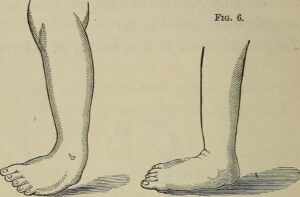What is a Club Foot (Talipes)?
Clubfoot, also known as congenital talipes equinovarus (CTEV), is a birth defect in which a baby’s foot is twisted downward and inward. It is a relatively common condition, affecting about 1 in every 1,000 live births. Clubfoot can affect one or both feet and without treatment, it can lead to significant mobility issues later in life. Fortunately, early diagnosis and treatment usually lead to good outcomes.
What Cause a Club Foot (Talipes)?
The exact cause of clubfoot is unclear, but it is believed to result from a combination of genetic and environmental factors. Babies with a family history of clubfoot are at higher risk of developing the condition. It can also be associated with certain neuromuscular disorders, but in most cases, it is an isolated deformity.

What are the Symptoms of a Club Foot (Talipes)?
The hallmark symptom of clubfoot is the abnormal position of the foot at birth. The foot is twisted downward and inward, causing the sole to face backward. The affected foot or leg may be slightly smaller or shorter than the other, and the calf muscles on the affected side may appear underdeveloped. Although clubfoot is not painful for infants, it can lead to difficulties with walking and discomfort later in life if left untreated.
How to Diagnose a Club Foot (Talipes)?
Clubfoot is usually diagnosed at birth through a physical examination. No additional tests are typically required, as the physical appearance of the foot is distinctive.

How to Treat a Club Foot (Talipes)?
Early treatment of clubfoot is essential for achieving the best outcomes. The goal is to correct the position of the foot and to prevent long-term disability.
The most widely used treatment is the Ponseti method, which involves gentle manipulation and serial casting of the foot over several weeks. The foot is gradually repositioned, and after casting, a minor surgery called a tenotomy may be performed to release the tight Achilles tendon. Following this, a brace is worn to maintain the correction and prevent relapse, often for several years.
An alternative approach is the French method, which emphasises daily physical therapy. This method involves daily stretching, massage, and taping to gradually improve the foot’s position. Unlike the Ponseti method, the French method requires ongoing involvement from both parents and therapists to ensure successful treatment.
In rare cases where non-surgical treatments do not fully correct the deformity, surgery may be required to adjust the tendons, ligaments, and bones of the foot.
Club Foot (Talipes) in summary:
Clubfoot is a treatable condition, and with early intervention, most children can walk and lead normal, active lives. The Ponseti and French methods are both effective in correcting the deformity and preventing long-term complications. Early diagnosis and consistent treatment are key to ensuring that children with clubfoot have the best possible outcomes.




